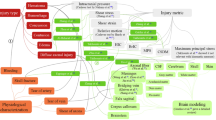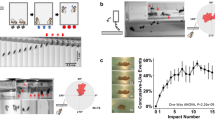Abstract
Background Non-accidental head injury (NAHI) is a form of child abuse where a perpetrator may violently subject an infant to repeated acceleration–deceleration forces with or without head impact, producing injuries including retinal haemorrhages in most cases. Animal models have included laboratory shaking of mice and rats, but only a small fraction develop retinal haemorrhages presumably due to the small eyes, which would require unattainable force levels to mimic that sustained by the infant eye. Animal models are also problematic due to ethical issues raised by subjecting even anaesthetized animals to abusive injury.
Methods We investigated a naturally occurring event, where three animal victims were shaken by a canine. The eyes were harvested and examined histologically.
Results The victims' eyes showed no haemorrhage or retinoschisis.
Conclusions Our model may not be a complete NAHI mimic. The discrepancies may ensue from anatomical and mechanical differences in the injury mechanism. Other models must be sought to further study this form of abusive eye injury.
Similar content being viewed by others
Introduction
Non-accidental head injury (NAHI; also known as abusive head injury or inflicted neurotrauma) is a form of child abuse where a perpetrator may violently subject an infant to repeated acceleration–deceleration forces with or without head impact (also known as shaken baby syndrome or shaken impact syndrome,), producing severe acute ocular, central nervous system, and skeletal injuries.1, 2 Retinal haemorrhages are a cardinal sign, occurring in a majority of cases.3, 4, 5 Although other factors may also be involved, retinal haemorrhages in NAHI are thought to primarily result from acceleration–deceleration-induced shearing forces.4 To study brain and retinal injury mechanisms in NAHI, animal models have included laboratory shaking of mice, cats, and pigs. The eyes have been examined in rat and mouse models, where only a small fraction of the animals develop retinal haemorrhages 6 (Levin et al; data not shown). Animal models are problematic due to ethical issues raised by subjecting even anaesthetized animals to abusive injury.
Other opportunities for studying ocular effects of abusive head injury include natural animal models. Shaking injuries inflicted on animals by other animals present a naturally occurring model of mechanical forces that suggest some similarity to those in NAHI. We present ocular findings from two kittens and a juvenile rabbit shaken to death by a dog.
Case report
The animals studied were two kittens from a stray litter, estimated to be 3–4 weeks old, and a common Texas jackrabbit of typical juvenile size. All animals were captured during an accidental encounter by an 18 kg mixed-breed canine using a bite to the haunches or posterior spine followed by aggressive side-to-side shaking, approximately 4–6 shakes. The animals were dead before they were dropped. All killings were witnessed by one author (SMB).
The animal carcasses were stored at −18°C for 1.5 weeks before enucleation. Eyes were enucleated with a short optic nerve segment, fixed in buffered formaldehyde, and shipped for pathological evaluation. The eyes were received by the pathologist (DR) approximately 2 months after enucleation.
The eyes of the two kittens and one rabbit showed no evidence of vitreous haemorrhage, retinal detachment, or retinoschisis. No retinal or optic nerve sheath haemorrhage was found. There was a 9 mm × 4 mm × 1.4 mm haematoma within the adipose tissue adherent to the globe of one rabbit eye.
Discussion
NAHI is a form of child abuse characterized by intracranial, skeletal, and ocular injury. The majority of cases involving repetitive acceleration–deceleration injury with or without impact demonstrate haemorrhagic retinopathy. A large body of literature and experimentation support the concept that shearing forces play an important role in the high incidence of macular retinoschisis.4 NAHI retinal haemorrhages are also thought to be in large part the result of acceleration–deceleration-induced shearing forces at the vitreoretinal interface and within the orbit, although other factors may also play a role in individual cases.4 To further study these mechanisms, a model of shaking injury in developing eyes is desired.
Ethical concerns prohibit experimental injury studies on children. We have examined woodpeckers as a potential naturally occurring animal model and are also using finite element analysis and dummy constructs.7 Proposed animal NAHI models include mice (eg, Smith et al8), cats (Levin AV, personal communication), and pigs.9 Eyes have been examined in mouse and pig models. In one study, 30% of mice developed retinal haemorrhages6; however, we were unable to replicate this finding, although we did not shake the mice upside down. Single acceleration–deceleration pig models have not demonstrated retinal haemorrhage.10 These findings contrast with NAHI (not including isolated single blunt impact), where 50–100% of patients have retinal haemorrhages. Larger animal models, with globe size and orbital characteristics closer to humans raise ethical issues, even in anaesthetized animals, when mechanisms of injury mimic abuse.
An alternative may be found in naturally occurring cases of animals shaken by other animals. We have investigated such a model of shaking injury produced by a dog that fatally shook two kittens and a rabbit. Pathological examination revealed no retinal haemorrhages, retinal detachment, retinoschisis, or optic nerve sheath haemorrhages. One animal had a unilateral small haemorrhagic area in the orbit. This is different than the more extensive orbital findings reported in NAHI,11 but may represent acceleration–deceleration-induced injury.
Ocular shearing forces in NAHI result from high-velocity movements of the victim's head in many directions. The animals we examined were all captured by a bite to the haunches and posterior spine. Although the victim animal's neck was not immobilized in the predator's jaws, it is possible that the greatest flexion occurred in the mid-spine rather than in the neck. This could have reduced the acceleration–deceleration shearing forces within the eyes and skull, particularly in the juvenile rabbit, which had well-developed musculature and a lower ratio of head mass to body mass than that of a kitten or human infant. If so, one explanation for the lack of retinal haemorrhage is that this model is not mechanically consistent with an NAHI-type injury.
The eyes of a 4-week-old kitten are on average 13 mm long;12 those of a 5–8-week-old rabbit are 12.3–13.3 mm long.13 A newborn human infant's eyes are 16–17 mm.14 Because of their smaller size, the victim animals' eyes require a greater amount of force to injure than those of a human infant. The fatal injury was inflicted by an 18 kg canine holding the victim in its jaws. Shaking force was generated by the canine's repetitive head movements through contraction of its neck muscles. Although we do not know the amount of force such an animal can generate, it may be insufficient to cause NAHI-like injury in the smaller eyes of the victim animals.
Among the anatomical factors that predispose infants and young children to NAHI are their large head and weak cervical musculature. Experimental acceleration–deceleration forces alone, when inflicted on laboratory cats, resulted in negligible morbidity and mortality.15 It is possible that the feline head and neck are better equipped to sustain acceleration–deceleration forces without injury. This would be in keeping with the natural behaviours of felines including leaping large heights without injury.
This natural model shaking-induced injury is not a complete mimic of the human counterpart. This may be attributed to anatomical and mechanical differences in the way that the injury was induced and the anatomy of the animal victims. Modelling of NAHI may require large animal laboratory models, finite element computer analysis, and dummy constructs. Clinical analysis of child victims of this form of abuse and other comparable illnesses and injuries remains an essential facet of research in this field.
References
Caffey J . On the theory and practice of shaking infants. Am J Dis Child 1972; 124: 161–169.
Caffey J . Multiple fractures in the long bones of infants suffering from chronic subdural hematoma. Am J Roentgenol Radium Ther Nucl Med 1946; 56: 163–173.
Harcourt B, Hopkins D . Ophthalmic manifestations of the battered baby syndrome. Br Med J 1971; 3: 398–401.
Levin AV . Retinal hemorrhages and child abuse. In: David TJ (ed). Recent Advances in Pediatrics. Churchill Livingston: London, England, 2000, pp 151–160.
Mushin A . Ocular damage in the battered baby syndrome. Br Med J 1971; 3: 402–404.
Bonnier C, Mesples B, Carpentier S, Henin D, Gressens P . Delayed white matter injury in a murine model of shaken baby syndrome. Brain Pathol 2002; 12: 320–328.
Wygnanski-Jaffe T, Murphy CJ, Smith C, Kubai M, Christopherson P, Ethier CR et al. Protective ocular mechanisms in woodpeckers. Eye 2007; 21(1): 83–89.
Smith SL, Andrus PK, Gleason DD, Hall ED . Infant rat model of the shaken baby syndrome: preliminary characterization and evidence for the role of free radicals in cortical hemorrhaging and progressive neuronal degeneration. J Neurotrauma 1976; 15: 693–705.
Raghupathi R, Mehr MF, Helfaer MA, Margulies SS . Traumatic axonal injury is exacerbated following repetitive closed head injury in the neonatal pig. J Neurotrauma 2004; 21(3): 307–316.
Binenbaum G, Forbes BJ, Reghupathi R, Judkins A, Rorke L, Margulies SS . An animal model to study retinal hemorrhages in nonimpact brain injury. J AAPOS 2007; 11(1): 84–85.
Levin AV, Wygnanski-Jaffe T, Shafiq A, Smith C, Enzenauer RW, Elder J et al. Postmortem orbital findings in shaken baby syndrome. Am J Ophthalmol 2006; 142(2): 233–240.
Thorn F, Gollender M, Erickson P . The development of the kitten's visual system. Vision Res 1976; 16(10): 1145–1149.
Choi MY, Yu YS . Effects of scleral buckling on refraction and ocular growth in young rabbits. Graefes Arch Clin Exp Ophthalmol 2000; 238(9): 774–778.
Bron JA . Wolff's Anatomy of the Eye and Orbit 8th ed. Lippincott Williams & Wilkins: Philadelphia, PA, 1997, pp 217.
Barron KD, Dentinger MP, Kimelberg HK, Nelson LR, Bourke RS, Keegan S et al. Ultrastructural features of a brain injury model in the cat. Acta Neuropathol(Berlin) 1988; 75: 295–307.
Acknowledgements
We thank Chad Morris BA for carcass transport, decapitation, and shipping. We are also grateful for the assistance of our Research Manager, Erica Bell and Research Assistant, Charmaine DeSouza. The corresponding author (AVL) had full access to all the data in the study and takes responsibility for the integrity of the data and the accuracy of the data analysis.
This study received funding in part from Brandan's Eye Research Fund.
Author information
Authors and Affiliations
Corresponding author
Additional information
Supplementary Information accompanies the paper on Eye website (http://www.nature.com/eye).
Supplementary information
Rights and permissions
About this article
Cite this article
Serbanescu, I., Brown, S., Ramsay, D. et al. Natural animal shaking: a model for non-accidental head injury in children?. Eye 22, 715–717 (2008). https://doi.org/10.1038/eye.2008.6
Received:
Accepted:
Published:
Issue Date:
DOI: https://doi.org/10.1038/eye.2008.6
Keywords
This article is cited by
-
Traumatic Brain Injury Using Mouse Models
Translational Stroke Research (2014)



